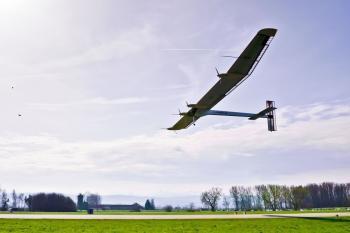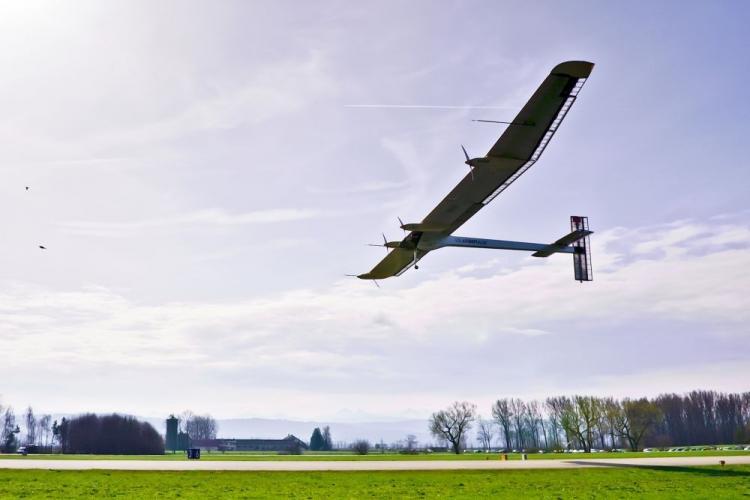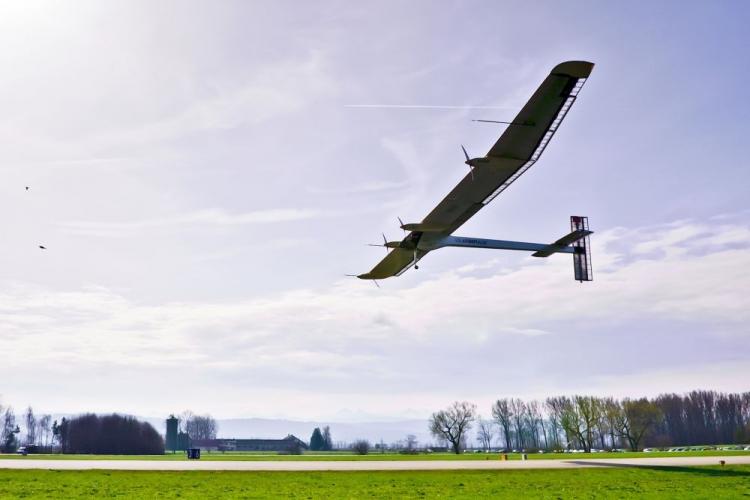Solar Impulse, a Swiss airplane prototype entirely powered by solar energy, successfully performed its first hours of flight in the morning of April 7.
The success came as good news for the 70 engineers who spent the past seven years of their lives with adventurer Bertrand Piccard on the project.
“This first mission was the most risky phase of the entire project,” said a delighted André Borschberg, CEO and co-founder of the project, adding that the flight took place in an hour and 27 minutes of “intense emotion.”
“Never has an airplane as large and light ever flown before!” Borschberg said. “The aim was to verify the prototype’s behavior in flight and to test its reaction to various maneuvers. The success of this first flight allows us to envisage the further program with greater serenity!”
Solar Impulse is powered by 12,000 photovoltaic cells mounted onto wings large as those of a Boeing 747 superjumbo. However, the plane body is around the size of a car, giving Solar Impulse the strange appearance of a dragonfly carried by four electric motors (10 horsepower each) linked to 880 pounds of lithium batteries.
The solar airplane made an easy take-off at speeds as low as 27 mph from Payerne military training center in western Switzerland, and smoothly landed at the same place 1 ½ hours later.
“Thanks to the extraordinary work of an entire team, an essential step towards achieving our vision has been taken,” said Bertrand Piccard on his Web site. “Our future depends on our ability to convert rapidly to the use of renewable energies. Solar Impulse is intended to demonstrate what can be done already today by using these energies and applying new technologies that can save natural resources.”
With dimensions of 71 feet in length, 208 feet in wing length, and 21 feet in height, and an average flight speed of 43 mph, Solar Impulse is definitely not intended to be distinguished by its speed.
Rather, the challenge is to prove that the future lies in renewable energy, and to illustrate this, Piccard’s team plans a 2013 flight around the world without using a single drop of oil.
Despite the major step, many additional tests will be needed before the around-the-world flight, the first one of which will be a 36-hour flight between May and June this year to assess the ability of Solar Impulse to fly—day and night.
The success came as good news for the 70 engineers who spent the past seven years of their lives with adventurer Bertrand Piccard on the project.
“This first mission was the most risky phase of the entire project,” said a delighted André Borschberg, CEO and co-founder of the project, adding that the flight took place in an hour and 27 minutes of “intense emotion.”
“Never has an airplane as large and light ever flown before!” Borschberg said. “The aim was to verify the prototype’s behavior in flight and to test its reaction to various maneuvers. The success of this first flight allows us to envisage the further program with greater serenity!”
Solar Impulse is powered by 12,000 photovoltaic cells mounted onto wings large as those of a Boeing 747 superjumbo. However, the plane body is around the size of a car, giving Solar Impulse the strange appearance of a dragonfly carried by four electric motors (10 horsepower each) linked to 880 pounds of lithium batteries.
The solar airplane made an easy take-off at speeds as low as 27 mph from Payerne military training center in western Switzerland, and smoothly landed at the same place 1 ½ hours later.
“Thanks to the extraordinary work of an entire team, an essential step towards achieving our vision has been taken,” said Bertrand Piccard on his Web site. “Our future depends on our ability to convert rapidly to the use of renewable energies. Solar Impulse is intended to demonstrate what can be done already today by using these energies and applying new technologies that can save natural resources.”
With dimensions of 71 feet in length, 208 feet in wing length, and 21 feet in height, and an average flight speed of 43 mph, Solar Impulse is definitely not intended to be distinguished by its speed.
Rather, the challenge is to prove that the future lies in renewable energy, and to illustrate this, Piccard’s team plans a 2013 flight around the world without using a single drop of oil.
Despite the major step, many additional tests will be needed before the around-the-world flight, the first one of which will be a 36-hour flight between May and June this year to assess the ability of Solar Impulse to fly—day and night.







